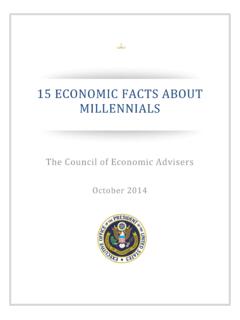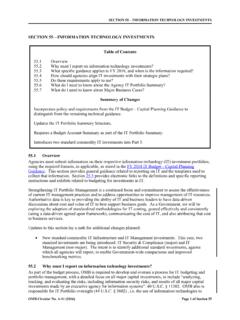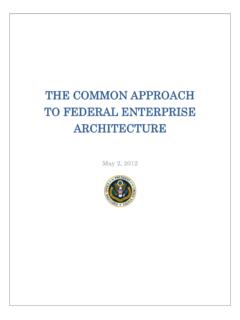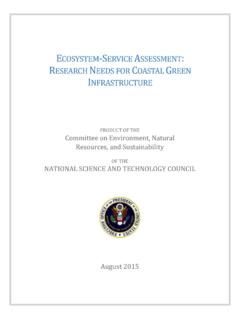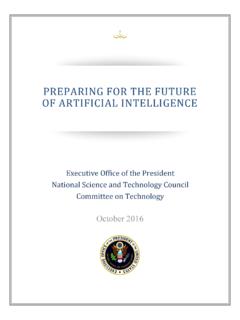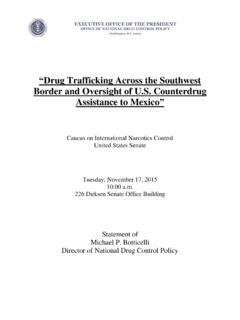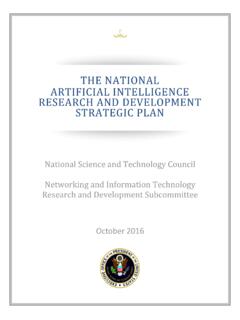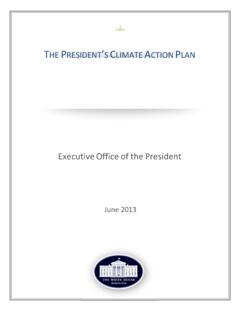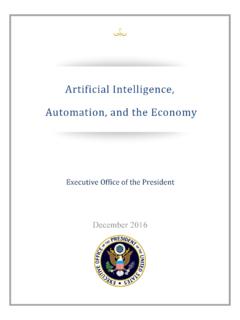Transcription of January 29, 2013 Iden fy Organiza ons Formalize Collabora ...
1 January 29, 2013. federal enterprise architecture framework Version 2. Service Delivery Governance enterprise Strategic Plan/Goals (PRM). Roadmap Strategic Plan/Goals (PRM). Strategic Plan/Goals (PRM). Business Strategic Plan/Goals (PRM). Strategic Plan / PriorityBusiness Goals Services Business Optimization Services Reporting (PRM). Integration Functional Business Data and Resource Method Services Human Capital Mgmt. (KSAs). Current Business Data and Future (Ex 53/ 300). Services Information (SRM). Segments (EVM). (BRM). Data Services and Information Views Data andEnabling Views Information Data and Enabling Security Controls Information Applications Program Mgmt. (DRM). Enabling Capital Planning Information Applications Enabling Host Applications Enabling Host Applications Infrastructure (ARM).
2 Host Applications Infrastructure Host Infrastructure Host Infrastructure (IRM). Infrastructure Transition Plan Standards Authoritative Reference Engage Sponsor and Iden fy Organiza ons Formalize Collabora ve Define Funding Strategy Operate with the New Assess Stakeholder and Service Providers to Planning Team and and Make Decision Capabili es Needs Engage Launch Planning Refine the Vision for Analyze and Validate Analyze Opportuni es Obtain Resources and Measure Performance Performance and Needs to Leverage Validate Plan Against Metrics Outcomes Analyze the Current Formulate Case to Determine Whether to State, Determine Analyze and Provide Execute the Plan Address the Needs Leverage Adjustments, and Plan Feedback the Target State Formulate the Iden fy and Engage Integrated Plan and Governance Roadmap Ini ate Execu on Governance 1.
3 January 29, 2013. Table of Contents 1 Introduction to the federal enterprise architecture framework (FEAF) v2 .. 11. 2 Overview of the Collaborative Planning Methodology .. 13. 3 Step 1: Identify and Validate .. 15. Purpose .. 15. The Planner's 15. Outcome .. 16. 4 Step 2: Research and Leverage .. 16. Purpose .. 16. The Planner's 16. Outcome .. 16. 5 Step 3: Define and Plan .. 17. Purpose .. 17. The Planner's 17. Outcome .. 17. 6 Step 4: Invest and Execute .. 18. Purpose .. 18. The Planner's 18. Outcome .. 18. 7 Step 5: Perform and Measure .. 18. Purpose .. 18. The Planner's 18. Outcome .. 19. 8 Overview of the Consolidated Reference Model .. 20. 9 Introduction to the Performance Reference Model.
4 23. Purpose of the Performance Reference Model .. 23. Structure of the Performance Reference Model .. 23. 10 Using the Performance Reference Model Taxonomy .. 24. Integrating CPIC (Exhibit 300) Performance Reporting with the FEA PRM .. 24. 11 PRM Touchpoints with other Reference Models .. 25. 12 Associated Methods/Best Practices for the PRM .. 25. 2. January 29, 2013. Line of 25. Selecting a Balanced Set of Exhibit 300 Performance 28. 13 PRM 28. 14 Introduction to the Business Reference Model .. 30. Purpose of the Business Reference Model .. 30. Structure of the Business Reference Model .. 30. 15 Using the Business Reference Model Taxonomy .. 31. Identifying opportunities to share services government-wide.
5 31. Reducing costs by eliminating duplication within the enterprise .. 31. 16 BRM Touchpoints with other Reference 32. 17 Associated Methods/Best Practices for the Business Reference Model .. 33. Business architecture for Decision Support .. 33. Business Process Modeling .. 34. 18 BRM Summary .. 34. 19 Introduction to the Data Reference Model .. 35. Purpose of the Data Reference Model .. 35. Structure of the Data Reference 35. 20 Using the Data Reference Model Taxonomy .. 36. Using the DRM to Compare Data Sources across federal Agencies .. 36. Using the DRM to Create a Standardized Information Exchange .. 36. 21 DRM Touchpoints with other Reference Models .. 37. 22 Associated Methods/Best Practices for the Data Reference Model.
6 37. Data Description .. 37. Data Context .. 38. Data Sharing .. 39. 23 DRM Summary .. 39. 24 Introduction to the Application Reference Model .. 41. Purpose of the Application Reference 41. Structure of the Application Reference Model .. 41. 25 Using the Application Reference Model .. 42. IT Cost Reduction through IT/ Application Portfolio Management .. 42. Using the ARM with the entire Consolidated Reference Model (CRM) .. 43. 3. January 29, 2013. 26 ARM Touchpoints with other Reference Models .. 43. 27 Associated Methods/Best Practices for the Application Reference 44. Capability Modeling and Analysis .. 44. Service Oriented architecture .. 44. Portfolio Management .. 45. 28 ARM Summary .. 45. 29 Introduction to the Infrastructure Reference Model.
7 46. Purpose of the Infrastructure Reference 46. Structure of the Infrastructure Reference 46. 30 Using the Infrastructure Reference Model Taxonomy .. 47. Using the IRM to Create an IT Asset Management (ITAM) .. 47. Using the IRM to Identify Opportunities for Shared Services .. 48. 31 IRM Touchpoints with other Reference Models .. 48. 32 Associated Methods/Best Practices for the Infrastructure Reference Model .. 49. Methods .. 49. Best Practices .. 49. 33 IRM 50. 34 Introduction to the Security Reference Model .. 51. Purpose of the Security Reference Model .. 51. Structure of the Security Reference Model .. 51. 35 Using the Security Reference Model Taxonomy .. 52. Using Standards to classify Policy at the International, National, federal , Sector, enterprise or Department Level.
8 52. Using Policy to select Controls at the Agency or Segment Level .. 53. Enforcing Design with Controls at the System or Application Level .. 53. 36 SRM Touchpoints with other Reference Models .. 54. 37 Associated Methods/Best Practices for the Security Reference Model .. 54. Risk Based 54. Security Controls .. 55. 38 SRM Summary .. 55. 39 Artifacts .. 57. Strategy Sub- architecture Domain .. 58. 4. January 29, 2013. Business Sub- architecture 59. Data Sub- architecture Domain .. 60. Applications Sub- architecture 62. Infrastructure Sub- architecture Domain .. 63. Security Sub- architecture 64. Appendix A: Collaborative Planning Methodology Guidance Document .. 65. Overview of the Collaborative Planning Methodology.
9 65. Step 1: Identify and Validate .. 67. Step 2: Research and Leverage .. 68. Step 3: Define and 68. Step 4: Invest and 69. Step 5: Perform and 70. Step 1: Identify and Validate .. 71. Step At-a-Glance .. 72. A Note on Core Artifacts .. 73. Activity : Engage Sponsor and Assess Stakeholder Needs .. 73. Activity : Analyze and Validate Needs .. 76. Activity : Formulate case to address the needs .. 78. Activity : Identify and Engage Governance .. 81. Step 2: Research and Leverage .. 85. Step At-a-Glance .. 86. A Note on Core Artifacts .. 87. Activity : Identify Organizations and Service Providers to Engage .. 87. Activity : Analyze Opportunities to Leverage .. 89. Activity : Determine Whether to Leverage.
10 92. Step 3: Define and 94. Step At-a-Glance .. 95. A Note on Core Artifacts .. 97. Activity : Formalize Collaborative Planning Team and Launch Planning .. 97. Activity : Refine the vision for performance and outcomes .. 100. Activity : Analyze the Current State, Determine Adjustments, and Plan the Target State .. 104. Activity : Formulate the Integrated Plan and Roadmap .. 125. 5. January 29, 2013. Activity : Initiate Execution 131. Step 4: Invest and Execute .. 135. Step At-a-Glance .. 137. A Note on Core Artifacts .. 137. Activity : Define Funding Strategy and Make Decision .. 138. Activity : Obtain Resources and Validate 139. Activity : Execute the Plan .. 139. Step 5: Perform and 141. Step At-a-Glance.
